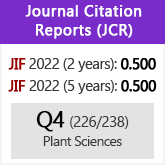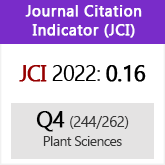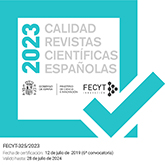Secondary metabolites of lichens in the snow zone of the Sierra Nevada in Mérida-Venezuela and their role in the absorption of ultraviolet radiation
DOI:
https://doi.org/10.3989/ajbm.2008.v65.i1.246Keywords:
lichen substances, UV radiation, UV filter, Venezuelan AndesAbstract
Photochemical analyses of secondary compounds in lichens from the venezuelan andean snow zone were carried out in order to know the absorbance capacity of UV radiation at the UVA, UVB and UVC ranges and to determine its probable UV protective function. Spectrophotometric (UV) and fine layer chromatographic techniques (TLC) were utilized to separate and identify the compounds. UV radiation values were obtained from the Red Bioclimática del Parque Nacional Sierra Nevada de Mérida which constitutes a program supported by the University of Los Andes, Venezuela. Results indicated the existence of 22 species of lichens at the snow zone; 55% of these species showed a strong resistance to UVC radiation, 95% to UVB radiation, whereas the 100% revealed a strong resistance to UVA radiation. The substances that have the highest resistance to UVA and UVB radiation are characterized by having ester bonds among phenolic units depsids and constitute the most abundant products in lichens, whereas the substances having both ester and ether bonds among the two phenolic units depsidones revealed a higher capacity to absorb UVC radiation that could indicate a primitive origin.
Downloads
References
Azócar, A. & Monasterio, M. 1980. Caracterización ecológica del clima en el páramo de Mucubají. In: Monasterio, M. (ed.), Estudios Ecológicos en los Páramos Andinos. Ediciones de la Universidad de Los Andes, Mérida, pp. 207-223.
Blumthaler, M. & Ambach, W. 1990. lndication of increasing solar Ultraviolet- B radiation flux in alpine regions. Science 248: 206-208. doi:10.1126/science.2326634 PMid:2326634
Caldwell, M., Robberecht, R. & Billings, W. 1980. A steep latitudinal gradient of solar ultraviolet-B radiation in the arctic-alpine life zone. Ecology 61: 600-611. doi:10.2307/1937426
Cockell, C.S. 2000a. The ultraviolet history of the terrestrial planets: Implications for biological evolution. Planetary and Space Science 48: 203-214. doi:10.1016/S0032-0633(99)00087-2
Cockell, C.S. 2000b. Ultraviolet radiation and the photobiology of Earth’s early oceans. Origins of Life and Evolution of Biospheres 30: 467-499. doi:10.1023/A:1006765405786 PMid:11002893
Cockell, C.S. & Horneck, G. 2001. The history of the UV radiation climate of the Earth-Theoretical and space-based observations. Photochemsrty and Photobiology 73: 447-451. doi:10.1562/0031-8655(2001)073<0447:THOTUR>2.0.CO;2 PMid:11332042
Culberson, C., Culberson, W. & Johnson, A. 1981. A standarized TLC analysis of -orcinol depsidones. The Bryologist 84: 16-29 doi:10.2307/3242974
Díaz, A., Péfaur, J. & Durant, P. 1997. Ecology of South American páramos with emphasis on the fauna of the Venezuelan moorland. In: Wielgolaski, F.E (ed.), Ecosystem of the World 3: Polar and Alpine Tundra, Elseive, Amsterdam, pp. 263-310.
Dvorkin, A.Y. & Steinberger, E.H. 1999. Modeling the altitude effect on solar UV radiation. Solar Energy 65: 181-187. doi:10.1016/S0038-092X(98)00126-1
Elix, J.A., Johnson, J. & Parker, J.L. 1987. Metabolites Users Manual. Second edition, Department of Chemistry, The Faculties, Australian National University, Camberra, Australia, p. 56.
Garcia-Pichel, F. 1998. Solar ultraviolet and the evolutionary history of cyanobacteria. Origins of Life and Evolution of the Biosphere 28: 321-347. doi:10.1023/A:1006545303412 PMid:9611770
Harborne, J.B. 1964. Biochemistry of phenolic compounds. Academic Press, New York, pp. 129.
Jagger, J. 1967. Introduction to Research in UV Photobiology, pp. 57. Jagger, J. 1985. Solar-UV actions on living cells. Praeger Scientific, New York, pp. 202.
López-Figueiras, M. 1986. Censo de Macrolíquenes de los Estados Falcón, Lara, Mérida, Táchira y Trujillo. Facultad de Farmacia. Universidad de Los Andes. Mérida, pp. 204.
Kasting, J.F., Whittet, D.C. & Sheldon, W.R. 1997. Ultraviolet radiation from F and K stars and implications for planetary habitability. Origins of Life and Evolution of the Biosphere 27: 413-420. doi:10.1023/A:1006596806012 PMid:11536831
Mancinelli, R.L. & White, M.R. 2000. Inhibition of denitrification by ultraviolet radiation. Advances in Space Research 26(12): 2041-2046.
Marcano, V. 1994. Introducción al estudio de los líquenes Andinos Venezolanos, Volumen I. Publicaciones de FUNDACITE Mérida, Immeca Press, Mérida, pp. 1-338.
Marcano, V. & Morales, A. 1994a. El género Alectoria Ach. (Ascomicetes liquenizados) en Los Andes de Venezuela. Ernstia 4: 89-100.
Marcano, V. & Morales, A. 1995. Revisión del género Umbilicaria (Ascomicetes liquenizados) en Venezuela. Ernstia 4: 21-35.
Marcano, V., Morales, A., Sipman, H. & Calderón, L. 1996. A first checklist of the lichen-forming fungi of the Venezuelan Andes. Tropical Bryology 12: 193-235.
Marcano, V., Galiz, L., Mohali, S. & al. 1997. Revisión del género Leprocaulon Nyl. ex Lamy (Lichenes Imperfecti) en Venezuela. Tropical Bryology 13: 47-56.
Marcano, V., Morales, A. & Rodríguez, V. 1999. Occurrence of usnic acid in Usnea laevis Nylander (Lichenized Ascomycetes) from the Venezuelan Andes. Journal of Ethnopharmacology 66: 343-346. doi:10.1016/S0378-8741(98)00181-0 PMid:10473183
McEvoy, M., Solhaug, A.K. & Gauslaa, Y. 2006. Ambient UV irradiation induces a blue pigment in Xanthoparmelia stenophylla. The Lichenologist 38: 285-289. doi:10.1017/S0024282906005706
Onofri, S., Selbmann, L., Zucconi L. & Pagano, S. 2004. Antarctic microfungi as models for exobiology. Planetary and Space Science 52: 229-237. doi:10.1016/j.pss.2003.08.019
Palacios, E. & Marcano, V. 2003. Introducción a la astrobiología. Desde el origen de la vida hasta el cerebro humano. En: Astrobiología. Desde las primeras moléculas hasta la aparición de la sinapsis. Universidad de Los Andes. Venezuela, pp. 3-33.
Piazena, H. 1996. The effect of altitude upon solar UV-B and UVA irradiance in the tropical Chilean Andes. Solar Energy 57: 133-140. doi:10.1016/S0038-092X(96)00049-7
Rikkinen, J. 2007. Photobiont-mediated lichen guilds. Comparative Biochemistry and Physiology-Part A: Molecular & Integrative Physiology 146: 219-220. doi:10.1016/j.cbpa.2007.01.480
Rothschild, L.J. & Mancinelli, R.L. 2001. Life in extreme environments. Nature 409: 1092-1101. doi:10.1038/35059215 PMid:11234023
Solhaug, A.K, Gauslaa, Y., Nybakken, L. & Bilger, W. 2002. Induction of pigment synthesis by UV irradiation in lichens. 13th Congress of the Federation of European Societies of Plant Physiology. Under the Aegisof the University of Crete. Editor Kalliopi A. Roubelakis-Angelakis.
Towers, G.H.N. 1964. Metabolism of phenolics in higher plants and microorganisms. In: Harborne, J.B. (ed.), Biochemistry of phenolic compounds, Academic Press, New York, pp. 249-294.
Downloads
Published
How to Cite
Issue
Section
License
Copyright (c) 2008 Consejo Superior de Investigaciones Científicas (CSIC)

This work is licensed under a Creative Commons Attribution 4.0 International License.
© CSIC. Manuscripts published in both the printed and online versions of this Journal are the property of Consejo Superior de Investigaciones Científicas, and quoting this source is a requirement for any partial or full reproduction.All contents of this electronic edition, except where otherwise noted, are distributed under a “Creative Commons Attribution 4.0 International” (CC BY 4.0) License. You may read here the basic information and the legal text of the license. The indication of the CC BY 4.0 License must be expressly stated in this way when necessary.
Self-archiving in repositories, personal webpages or similar, of any version other than the published by the Editor, is not allowed.

















